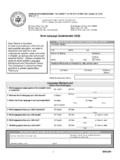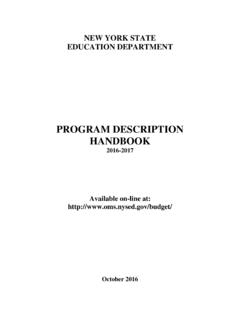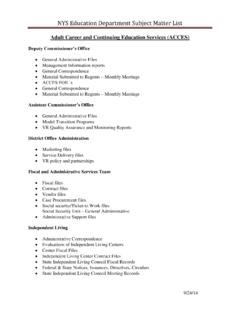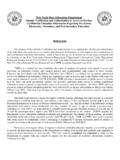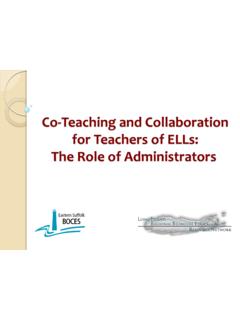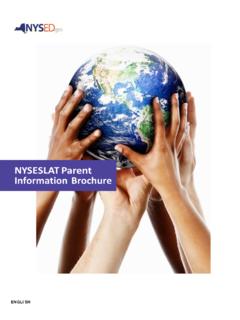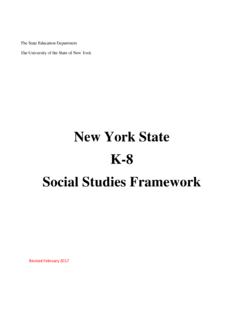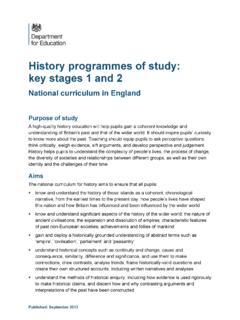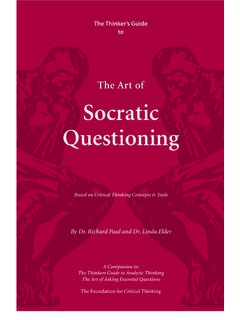Transcription of New York State Common Core Social Studies 9-12 Framework
1 The State Education Department The University of the State of New York New York State Grades 9-12. Social Studies Framework Revised January 2015. Contents Social Studies Practices Grades 2. Grades 9 and 4. Common Core .. 5. Reading Standards for Literacy in history / Social Studies .. 5. Writing Standards for Literacy in history / Social Studies , Science and Technical Subjects .. 6. Speaking and Listening 7. Global history and Geography .. 9. Grade 9: Unifying Themes Aligned to Key Ideas .. 10. Grade 9: Global history and Geography I .. 11. Grade 10: Unifying Themes Aligned to Key Ideas .. 19. Grade 10: Global history and Geography II .. 20. Grades 11 12 .. 28. Common Core .. 29. Reading Standards for Literacy in history / Social Studies .
2 29. Writing Standards for Literacy in history / Social Studies , Science, and Technical Subjects .. 30. Common Core Standards Speaking and Listening .. 31. Grade 11: Unifying Themes aligned to Key Ideas .. 33. Grade 11: United States history and Government .. 34. Grade 12: Participation in Government and 45. Grade 12: Economics, the Enterprise System, and Finance .. 48. Grades 9-12 Page 1. Social Studies Practices Grades 9-12. A. Gathering, Interpreting, and Using Evidence 1. Define and frame questions about events and the world in which we live, form hypotheses as potential answers to these questions, use evidence to answer these questions, and consider and analyze counter-hypotheses. 2. Identify, describe, and evaluate evidence about events from diverse sources (including written documents, works of art, photographs, charts and graphs, artifacts, oral traditions, and other primary and secondary sources).
3 3. Analyze evidence in terms of content, authorship, point of view, bias, purpose, format, and audience. 4. Describe, analyze, and evaluate arguments of others. 5. Make inferences and draw conclusions from evidence. 6. Deconstruct and construct plausible and persuasive arguments, using evidence. 7. Create meaningful and persuasive understandings of the past by fusing disparate and relevant evidence from primary and secondary sources and drawing connections to the present. B. Chronological Reasoning and Causation 1. Articulate how events are related chronologically to one another in time and explain the ways in which earlier ideas and events may influence subsequent ideas and events. 2. Identify causes and effects using examples from different time periods and courses of study across several grade levels.
4 3. Identify, analyze, and evaluate the relationship between multiple causes and effects 4. Distinguish between long-term and immediate causes and multiple effects (time, continuity, and change). 5. Recognize, analyze, and evaluate dynamics of historical continuity and change over periods of time and investigate factors that caused those changes over time. 6. Recognize that choice of specific periodizations favors or advantages one narrative, region, or group over another narrative, region, or group. 7. Relate patterns of continuity and change to larger historical processes and themes. 8. Describe, analyze, evaluate, and construct models of historical periodization that historians use to categorize events.
5 C. Comparison and Contextualization 1. Identify similarities and differences between geographic regions across historical time periods, and relate differences in geography to different historical events and outcomes. 2. Identify, compare, and evaluate multiple perspectives on a given historical experience. 3. Identify and compare similarities and differences between historical developments over time and in different geographical and cultural contexts. 4. Describe, compare, and evaluate multiple historical developments (within societies; across and between societies; in various chronological and geographical contexts). 5. Recognize the relationship between geography, economics, and history as a context for events and movements and as a matrix of time and place.
6 6. Connect historical developments to specific circumstances of time and place and to broader regional, national, or global processes and draw connections to the present (where appropriate). D. Geographic Reasoning 1. Ask geographic questions about where places are located, why their locations are important, and how their locations are related to the locations of other places and people. 2. Identify, describe, and evaluate the relationships between people, places, regions, and environments by using geographic tools to place them in a spatial context. Grades 9-12 Page 2. 3. Identify, analyze, and evaluate the relationship between the environment and human activities, how the physical environment is modified by human activities, and how human activities are also influenced by Earth's physical features and processes.
7 4. Recognize and interpret (at different scales) the relationships between patterns and processes. 5. Recognize and analyze how place and region influence the Social , cultural, and economic characteristics of civilizations. 6. Characterize and analyze changing connections between places and regions. E. Economics and Economics Systems 1. Use marginal benefits and marginal costs to construct an argument for or against an approach or solution to an economic issue. 2. Analyze the ways in which incentives influence what is produced and distributed in a market system. 3. Evaluate the extent to which competition between sellers and between buyers exists in specific markets. 4. Describe concepts of property rights and rule of law as they apply to a market economy.
8 5. Use economic indicators to analyze the current and future State of the economy. 6. Analyze government economic policies and the effects on the national and global economy. F. Civic Participation 1. Demonstrate respect for the rights of others in discussions and classroom debates;. respectfully disagree with other viewpoints and provide evidence for a counter-argument. 2. Participate in activities that focus on a classroom, school, community, State , or national issue or problem. 3. Explain differing philosophies of Social and political participation and the role of the individual leading to group-driven philosophies. 4. Identify, describe, and contrast the roles of the individual in opportunities for Social and political participation in different societies.
9 5. Participate in persuading, debating, negotiating, and compromising in the resolution of conflicts and differences. 6. Identify situations in which Social actions are required and determine an appropriate course of action. 7. Work to influence those in positions of power to strive for extensions of freedom, Social justice, and human rights. 8. Fulfill Social and political responsibilities associated with citizenship in a democratic society and interdependent global community by developing awareness of and/or engaging in the political process. Grades 9-12 Page 3. Grades 9 and 10. Grades 9-12 Page 4. Common Core Reading Standards for Literacy in history / Social Studies Key Ideas and Details 1. Cite specific textual evidence to support analysis of primary and secondary sources, attending to such features as the date and origin of the information.
10 2. Determine the central ideas or information of a primary or secondary source; provide an accurate summary of how key events or ideas develop over the course of the text. 3. Analyze in detail a series of events described in a text; determine whether earlier events caused later ones or simply preceded them. Craft and Structure 4. Determine the meanings of words and phrases as they are used in a text, including vocabulary describing political, Social , or economic aspects of history / Social Studies . 5. Analyze how a text uses structure to emphasize key points or advance an explanation or analysis. 6. Compare the points of view of two or more authors in their treatments of the same or similar topics, including which details they include and emphasize in their respective accounts.
